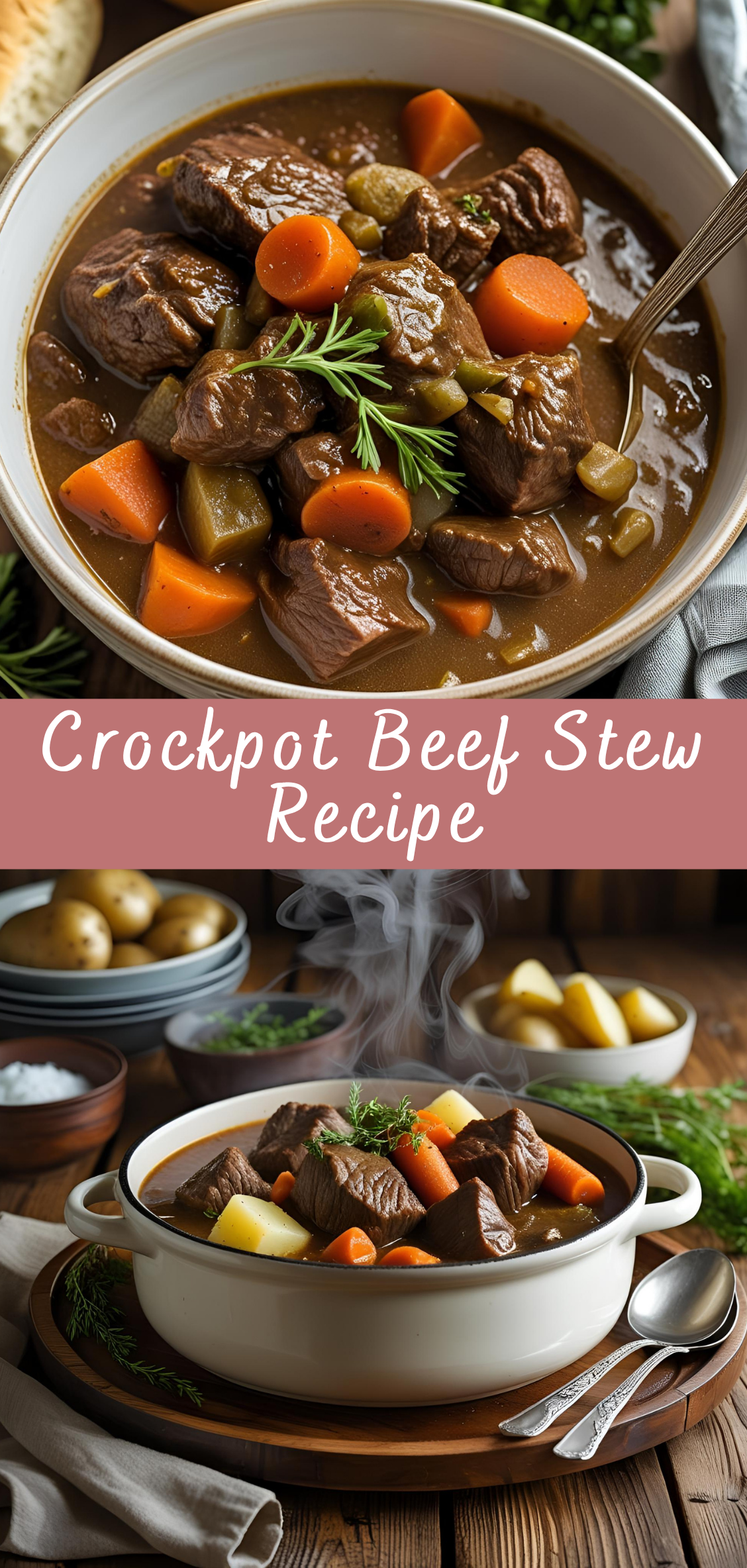Crockpot Beef Stew Recipe
Beef stew is one of those timeless dishes that transcends borders, generations, and culinary trends. Rooted in the basic human need for nourishment and warmth, beef stew has evolved over the centuries from a simple peasant fare to a beloved family classic in kitchens around the world. Among the many variations of this hearty meal, Crockpot Beef Stew stands out for its convenience, depth of flavor, and the comfort it brings to the table. As modern schedules grow increasingly busy, the slow cooker—or Crockpot—has become an essential kitchen appliance, turning traditional recipes into effortless weekday staples. This method not only saves time and energy but also allows for the natural flavors of the ingredients to marry over a long, gentle cooking process.

The Crockpot Beef Stew is more than just food—it’s a ritual. It begins in the morning with the chopping of fresh vegetables and the browning of beef, then continues through the day as the aroma slowly fills the home, promising a satisfying, home-cooked meal. For many, the scent of a simmering beef stew is inextricably linked to memories of family dinners, cold winter nights, and the quiet joy of gathering around the table. Whether it’s being served on a Sunday evening or prepared for a crowd during the holidays, beef stew has a unique power to bring people together.
Slow-cooked beef stew dates back to rustic European traditions where tough cuts of meat were tenderized through long, slow cooking—turning what was once considered less desirable cuts into meltingly tender morsels of flavor. In France, the dish is known as boeuf bourguignon; in Ireland, it’s the foundation of their iconic Irish stew. Each country brings its own ingredients and techniques to the dish, yet the core remains the same: meat, vegetables, broth, and time. The Crockpot version we know today is an evolution of these age-old traditions, adapted for the pace and practicality of modern life.
The use of the slow cooker allows even novice home cooks to achieve professional-level results. The device is especially ideal for tougher cuts of meat like chuck roast, which, while affordable, contain connective tissue and marbling that break down beautifully over the course of hours in low heat. The end result is fork-tender beef that melts in your mouth, enveloped in a savory broth thickened with natural starches released from the vegetables and the meat itself. Adding layers of seasoning and aromatics—such as thyme, bay leaves, garlic, and even a splash of red wine—brings out complex flavors that are hard to replicate with faster cooking methods.
But Crockpot Beef Stew isn’t just about ease and flavor; it’s also about nourishment. It is a nutritionally balanced one-pot meal, offering high-quality protein, complex carbohydrates, dietary fiber, and a host of vitamins and minerals from the vegetables and broth. It is as suitable for a health-conscious eater as it is for someone looking for a filling, wholesome dish that satisfies body and soul. The stew can be customized in myriad ways to suit different dietary needs or taste preferences—whether that means reducing sodium, eliminating gluten, using organic ingredients, or experimenting with low-carb substitutions.
Cultural relevance also plays a role in the enduring appeal of this dish. Across many societies, food serves as a conduit for connection, heritage, and tradition. Preparing a Crockpot Beef Stew may seem like a routine act, but it is one steeped in history and culture. From the medieval European stew pots to modern-day electric slow cookers, this humble dish represents centuries of adaptation, innovation, and community. It’s no coincidence that stew recipes are often passed down through generations—each version unique, but all rooted in the same essential qualities of comfort, nutrition, and care.
This guide will take a deep dive into every aspect of Crockpot Beef Stew—from its historical context to ingredient selection, step-by-step cooking techniques, nutritional value, tips for enhancement, and creative variations. Whether you’re a beginner in the kitchen or a seasoned home cook looking to refine your go-to stew, the following pages will provide you with a thorough understanding of how to craft a stew that’s not only delicious, but meaningful.
In an age where fast food and pre-packaged meals often dominate dinner tables, returning to a slow-cooked classic like beef stew feels both nostalgic and necessary. It reminds us to slow down, to savor, and to appreciate the simple, timeless act of cooking with care. This is more than just a recipe; it’s a celebration of tradition, flavor, and the quiet joys of home cooking.
Historical Background
The story of beef stew stretches far back into human history, predating modern kitchens and cookware. It is a story of resilience, resourcefulness, and the eternal pursuit of nourishment. Stews have been a staple in cultures around the world for thousands of years. Archaeological evidence suggests that as early as 6,000 B.C., humans were using primitive vessels to cook meat and vegetables over an open flame, creating rudimentary stews. These early forms of stewing represented a major leap in culinary development, allowing tough cuts of meat and fibrous vegetables to be made tender and palatable with the simple application of time and heat.
One of the key reasons for the global spread of stew-based dishes is its economy and adaptability. In regions where resources were scarce, stews provided a way to extend limited supplies of meat and vegetables. The technique maximized flavor and minimized waste, enabling people to create wholesome, filling meals out of humble ingredients. Over time, each region developed its own interpretation of stew based on available ingredients, climate, and culture.
In medieval Europe, for instance, large pots were kept simmering over hearth fires, often for days on end, with various ingredients being added as they became available. These perpetual stews were rarely the same from one day to the next. In France, beef stew took on a more refined identity with dishes like boeuf bourguignon—a wine-infused beef stew made with carrots, onions, and herbs, slow-cooked to tender perfection. The dish was particularly associated with the Burgundy region and its robust red wines.
In the British Isles, the tradition of hearty meat stews is represented by the iconic Irish stew, typically made with lamb or beef, potatoes, carrots, and onions. It was both a reflection of and response to Ireland’s agricultural landscape and economic history. Meanwhile, in Eastern Europe, beef stews like Hungarian goulash emphasized paprika and other bold spices, while Russian stroganoff used sour cream and mustard for a richer, tangier profile.
Outside of Europe, beef stew took on different forms. In Latin America, dishes like carne guisada integrated chili peppers, tomatoes, and cumin. In West Africa, peanut-based stews with chunks of beef offered warmth and sustenance. Asian stews like Korean galbijjim (braised short ribs) or Chinese red-braised beef stew reveal a tradition of slow-cooking meat with soy sauce, ginger, and star anise. Despite cultural differences, the essence remained the same: slow-cooked meat in a rich, savory liquid.
The modern Crockpot Beef Stew, while distinctly American in its appliance-based preparation, owes much to these historical precedents. The slow cooker itself was introduced in the 1970s, a time when American households were increasingly looking for kitchen efficiency and convenience. Rival Manufacturing Company released the original Crock-Pot, advertising it as a way for busy homemakers to serve nourishing meals without having to tend to the stove all day. It was particularly well-suited for stews, which required long, gentle cooking—a match made in culinary heaven.
By the late 20th century, the Crockpot had become a ubiquitous appliance in American kitchens. It enabled cooks to prepare meals in the morning, leave them to simmer unattended throughout the day, and return home to a hot, fully-cooked dish. This changed not only how meals were made, but when and why. Weeknight dinners became more manageable; Sunday meals more relaxed. In many households, the act of “setting the Crockpot” became a morning ritual as familiar as brewing coffee.
The appeal of Crockpot Beef Stew lies in its ability to marry traditional flavor with modern convenience. The basic components—beef, root vegetables, broth, and seasonings—mirror ancient recipes, but the preparation fits neatly into the rhythms of contemporary life. What once took constant tending over an open fire can now be accomplished with a few hours of passive cooking in a countertop appliance.
Understanding the historical roots of beef stew enriches the cooking experience. It connects the home cook not only to centuries of culinary wisdom but also to a global tradition of feeding, caring, and sharing. A bowl of beef stew, then, is never just a meal; it is a link to the past, a celebration of cultural ingenuity, and a warm, fragrant symbol of comfort that transcends time and place.
Crockpot Beef Stew Recipe
Beef stew is one of those timeless dishes that transcends borders, generations, and culinary trends. Rooted in the basic human need for nourishment and warmth, beef stew has evolved over the centuries from a simple peasant fare to a beloved family classic in kitchens around the world. Among the many variations of this hearty meal, Crockpot Beef Stew stands out for its convenience, depth of flavor, and the comfort it brings to the table. As modern schedules grow increasingly busy, the slow cooker—or Crockpot—has become an essential kitchen appliance, turning traditional recipes into effortless weekday staples. This method not only saves time and energy but also allows for the natural flavors of the ingredients to marry over a long, gentle cooking process.
Ingredients
- 2 lbs beef stew meat (chuck roast, cut into 1–2 inch pieces)
- 4 medium carrots, peeled and sliced
- 3 medium potatoes, peeled and diced
- 3 celery stalks, sliced
- 1 medium onion, chopped
- 3 cloves garlic, minced
- 3 cups beef broth (low sodium)
- 2 tbsp tomato paste
- 1 tbsp Worcestershire sauce
- 1 tsp salt (adjust to taste)
- ½ tsp black pepper
- 1 tsp dried thyme
- 1 tsp dried rosemary
- 2 tbsp olive oil (for browning beef, optional)
- 2 tbsp cornstarch + 2 tbsp water (optional, for thickening)
Instructions
- Optional – Brown the Beef:
In a skillet, heat olive oil over medium-high heat. Sear beef in batches until browned on all sides (3–4 minutes per batch). This step adds flavor but can be skipped. - Add Ingredients to Crockpot:
Place the beef, carrots, potatoes, celery, onion, and garlic into the slow cooker. - Add Liquids & Seasonings:
Pour in the beef broth. Stir in tomato paste, Worcestershire sauce, salt, pepper, thyme, and rosemary. - Cook:
Low: 8–9 hours
High: 4–5 hours
Stew is done when the beef is tender and vegetables are soft. - Thicken the Stew (Optional):
In the last 30 minutes of cooking, mix 2 tbsp cornstarch with 2 tbsp water and stir into the stew. Let it cook uncovered for the final 30 minutes to thicken. - Taste and Adjust:
Taste and add salt, pepper, or additional herbs if needed. - Serve:
Serve hot with crusty bread or over mashed potatoes.
Notes
- Meat options: Chuck roast gives the best flavor and tenderness.
- Vegetable tips: Add frozen peas during the last 10 minutes for a pop of color.
- Make ahead: Pre-chop veggies and meat the night before for quicker morning prep.



